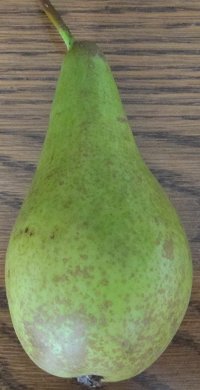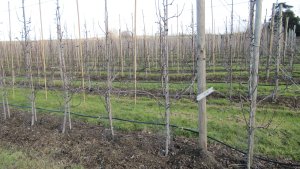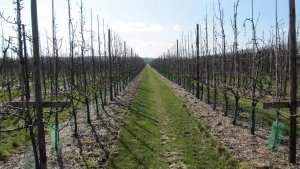

Is spring in the air a last?
March came in like a Lamb; will it go out like a Lion?
Pear Growing in the UK: Last week I attended a conference at East Malling Research (EMR) created to stimulate the UK pear industry towards modern pear production. We in the UK have a long history of pear growing, but over the last 20 years our industry has fallen badly behind our overseas competitors, in particular Holland & Belgium who have forged ahead with modern production methods while we have 'by and large' plodded along with growing systems designed 50 years ago when import competition was non existent.
Too often we have played the ostrich (head in the sand) protesting about their perceived advantages; climate, rules of engagement, e.g. EU grants, preferential Benelux tax arrangements and pesticide usage laws. Now this is not all 'humbug' and the playing field has NOT been a truly level one in the past. Prices for pears while not high, were always enough to make UK pear production a 'steady earner' this has changed dramatically over the last 10-15 years and most UK pear growers have consistently lost money. The pear industry is dominated by Conference Pears and the Dutch & Belgian fruit is bolder in size and has a superior skin finish; green with not too much skin russet. UK pears have a tendency to carry much more rough russet leading to inferior gradeouts and less attractive appearance on the Supermarket shelf.
The pear industry is dominated by Conference Pears and the Dutch & Belgian fruit is bolder in size and has a superior skin finish; green with not too much skin russet. UK pears have a tendency to carry much more rough russet leading to inferior gradeouts and less attractive appearance on the Supermarket shelf.
The Market: Adrian Barlow, Chief Executive of English Apples & Pears reviewing the UK Pear market emphasized the huge potential for English pears. Adrian illustrated the governments desire for an increase of 20-25% in UK produced food, creating a producer and consumer 'mindset' for exploring the potential of increased 'home grown' produce.
Adrian told us the UK pear market consumes about 160,000 tonnes of which 30,000 tonnes goes for juice. Of this only 30,000 tonnes is grown in the UK and only 20,000 tonnes is sold as fresh fruit. Of this 20K tonnes the majority is Conference. Comice & Concorde making up most of the remaining tonnage. Pears make up approximately 5.5% of the UK fruit market. Conference also dominates the annual pear sales with circa 60K tonnes = 47% of all pears sold. The 40+ age group are the main consumers of pears and the UK consumer eats less than half the pears eaten in other EU countries and only 20% by comparison with Italy.Pear yields in the UK average only 13.7 tonnes per hectare while our main competitors are way ahead with; Belgium 34.6 tonnes & Holland 35.6 tonnes.
Challenge is a fantastic stimulant: In so many areas of life we do not perceive possible many developments which change our lives until 'necessity comes calling! We English also have a remarkable habit of leaving change until desperation drives the need. History tells us that we are very good at seizing 'victory from the jaws of defeat' and there are parallels that can be drawn in the Apple & Pear industry; we sit easily on our laurels, happy with life until faced with a challenge; then after a period of resignation and impending defeat, 'John Bull' or in this case, when innovative natural leaders fight back with great determination and save our bacon at the eleventh hour.
 The Future: For the UK pear industry to survive, let alone prosper we must develop a more intensive approach to pear production. The opportunity for profitable sales is there, but only if we can produce heavier crops of better quality pears. At the Pear Conference we had the good fortune to be addressed by technical experts from Holland, Belgium and England, in addition James Simpson a leading English grower and Theresa Huxley, Product Technologist for Sainsburys, the most supportive UK retailer, which sells more than 30% of all English pears, far more than any other retailer.
The Future: For the UK pear industry to survive, let alone prosper we must develop a more intensive approach to pear production. The opportunity for profitable sales is there, but only if we can produce heavier crops of better quality pears. At the Pear Conference we had the good fortune to be addressed by technical experts from Holland, Belgium and England, in addition James Simpson a leading English grower and Theresa Huxley, Product Technologist for Sainsburys, the most supportive UK retailer, which sells more than 30% of all English pears, far more than any other retailer.
Theresa emphasised the enormous opportunity for English pears; reiterating that annual sales of all pears in the UK reach160,000 tonnes of which UK growers contribute just 30,000 tonnes. Of this 30K tonnes only 20,000 tonnes are suitable for retail sale; the balance are only suitable for juice. In turn, only recently has a juice market for pears been resurrected. Older readers will remember 'Babycham' a sparkling perry drink; very fashionable when I was courting my wife 50 + years ago!
Sainsburys commitment to UK Pears is evident by trying to encompass as much of the UK crop with a range of fruit sold. By selling only English Conference pears in our season and by using three categories of Basic, Standard and Taste the Difference helps the grower by utilizing as much as possible of the harvested fruit and delivers a price and visual quality spectrum for all consumers. Theresa pointed out that while size and visual quality differs in the 3 categories, eating quality specification does not! In the picture showing Conference Pear shapes; The 3 on the left meet Class 1 specification, while the three on the right do not! Sainsburys Basic pack accepts the poor shape (Class 2 ) Pears.
The Grower: James Simpson representing Adrian Scripps Ltd one of England's largest and most progressive pear growers, told us how his company had intensified their pear orchards. Recent plantings are much more intensive, with around 3,000 trees per hectare; establishment cost is in the order of £15,000 - £18,000 per hectare. This intensive planting is a huge investment compared to plantings made 30-50 years ago when the old 'adage' You plant, Pears for your heirs, was still a strongly held belief; based then on the less intensive planting distances and the slow build up of yields, but made viable by the lack of imported competition resulting in profitable returns. In 2010 providing nature is supportive and prices are fair, these intensive orchards can deliver a positive cash-flow in 5-6 years when establishment cost, and accrued annual costs, are overtaken by financial returns. James demonstrated the vast uplift in yields achieved with intensive planting. Scripps orchards, on a rolling 5 year average are achieving 27 tonnes per hectare, with highs of 38 tonnes and lows of 25 tonnes. Even with this high quality management James pragmatically points out that Conference pear yields are well below the capability of their Apple orchards.
In 2010 providing nature is supportive and prices are fair, these intensive orchards can deliver a positive cash-flow in 5-6 years when establishment cost, and accrued annual costs, are overtaken by financial returns. James demonstrated the vast uplift in yields achieved with intensive planting. Scripps orchards, on a rolling 5 year average are achieving 27 tonnes per hectare, with highs of 38 tonnes and lows of 25 tonnes. Even with this high quality management James pragmatically points out that Conference pear yields are well below the capability of their Apple orchards.
The Technical Expert: Tim Biddlecombe, Managing Director of FAST the leading independent advisory company reiterated the importance of intensification. Tim considers 3,000 trees per hectare; equal to 1,250 tree per acre, to be the optimum density if UK growers are to compete with the Benelux countries. Historically we have believed Dutch & Belgian growers benefit form better weather conditions. Tim explored the truth of these speculations by drawing an imaginary line between Faversham close to the main UK pear production region in East Kent and Masstricht, encompassing the core of Benelux production, Tim produced data of the ten year average, clearly showing slightly higher temperatures in Faversham in the spring time, which triggers bud development earlier than the continent, while significantly, during the summer months of June and July the temperatures in the Benelux orchards are consistently higher than in East Kent. This is a critically advantageous temperature profile for Dutch & Belgian growers. The later start protects them from the risk of frost and chilling winds in spring time while enhancing fruit development during June & July. It would appear we cannot overcome this climatic advantage our competitors enjoy. Superior size, skin finish and yield will remain their advantage.
My prognosis: Clearly English growers are, and must continue to intensify pear orchards. This will bring us much closer to equaling our competitors financial prospects. However English pears will still depend on 'mother nature' for the visual quality. It is unlikely we can achieve the clean green Conference Pears of our competitors and we need a little help from retailers and consumers with improved prices. With a lot of effort from us and support from the consumer we can look forward to more home grown produce.
In summary: There is one area where we excel in this country; FLAVOUR. While specifications for Pears frustrate growers due to the level of russet on the skin not exceeding notional levels, it is my firm belief that it is a PROVEN science that fruit with russet, be it Pears or Apples has a much sweeter flavour. My shopping basket always contains Conference Pears, normally I choose 'The Ripe & Ready' option, and on returning home place them in the fridge. I have often kept the 'R&R' pears in the fridge for up to a month (not advised) and they continued to eat as well as when first purchased. One thing is certain, however good the appearance of the imported Conference may be, the English have a better flavour.
Until next week
The English Apple Man
PS: My apologies for late posting!